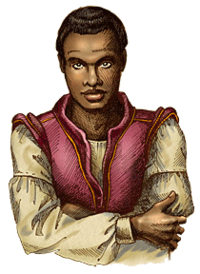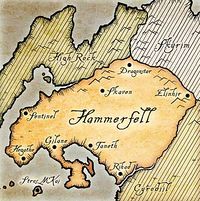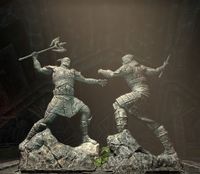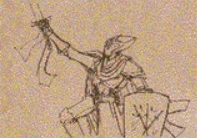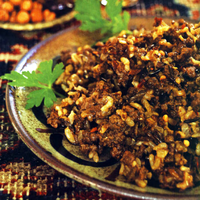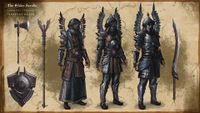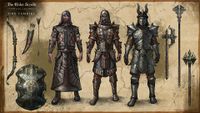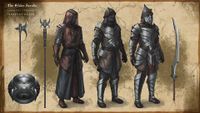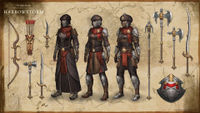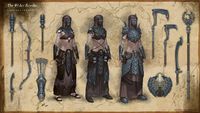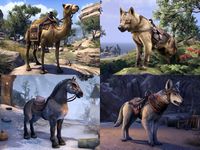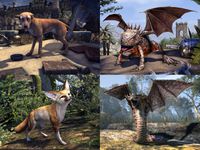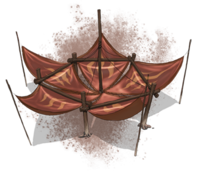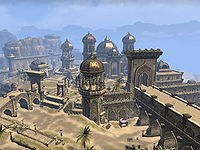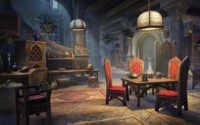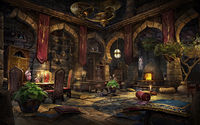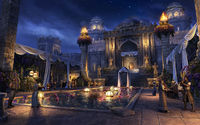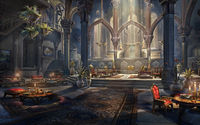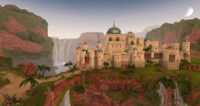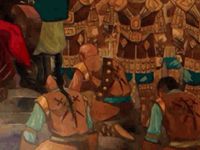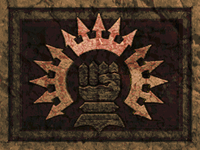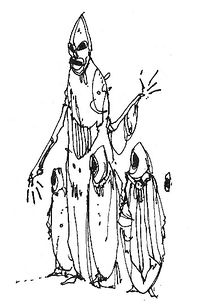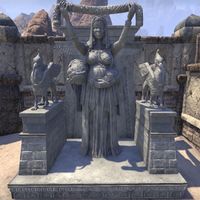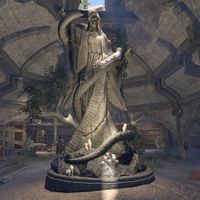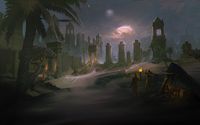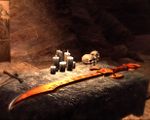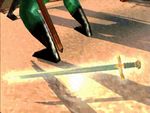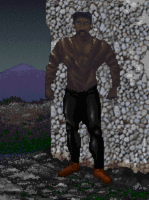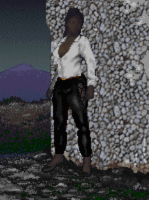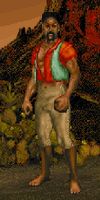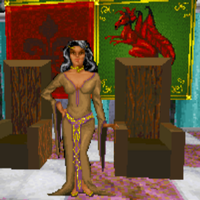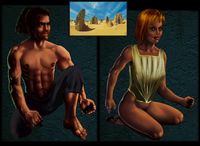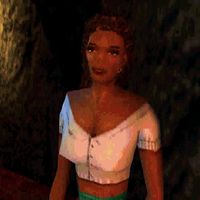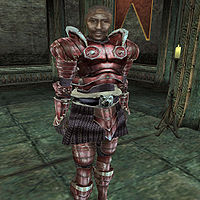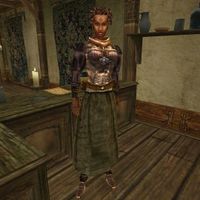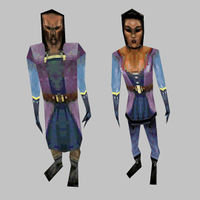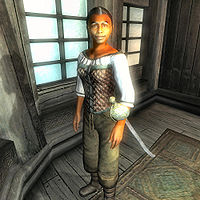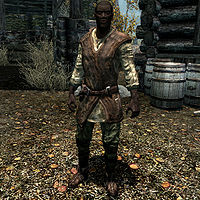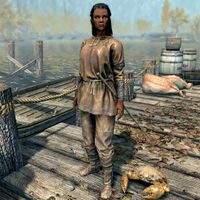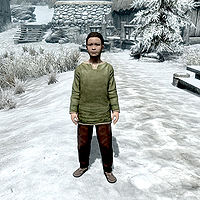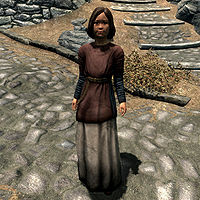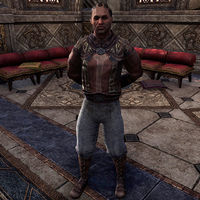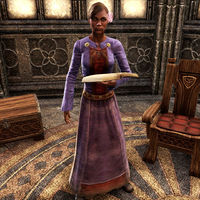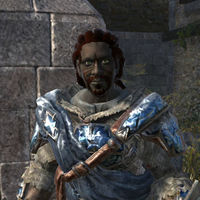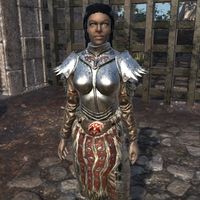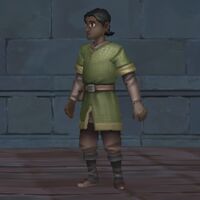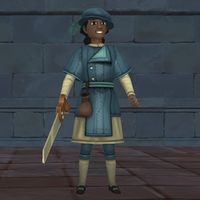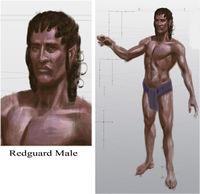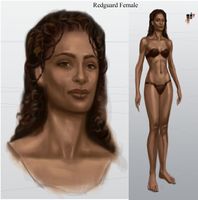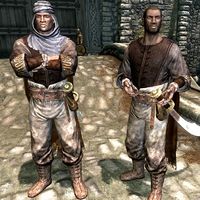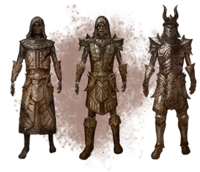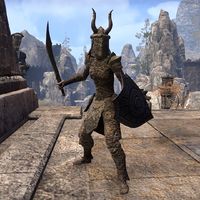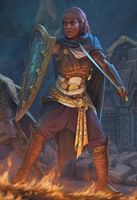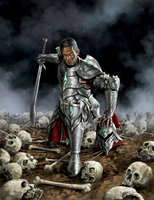Lore:Redguard
Redguards are a human race that primarily inhabits the province of Hammerfell, but have roots that can be traced back to the continent of Yokuda.[1] Known for their unique martial culture, they are reputed as brilliant battlefield tacticians[2] who are quick to adopt new styles of armor and weaponry. They are the most naturally talented warriors in Tamriel.[3] Hammerfell was formerly known as the Deathlands, as it hosts an arid climate with stifling, sandy winds, baking rocks that would brand one's feet, and terrible creatures that dwell in the crags and dunes. Regardless, conquering this hostile environment has become synonymous with Redguard culture.[1][4] Aside from being physically blessed with hardy constitutions, they also have a resistance to poison and fleetness of foot.[5] Redguards are known for their love of traveling, adventuring, and sailing the high seas: they can be seen commonly throughout Tamriel as sailors and mercenaries.[6][7]
Redguards are known for their tall, gaunt frames and finely toned physiques.[7] They possess above average human strength and agility, and show a remarkable capacity for surviving in hot, dry climates. They generally possess dark skin, ranging from light brown in hue, to nearly black, and often with a significant red tint. They possess hair ranging from wavy to very curly, wiry hair,[8] and their degree of body hair varies. Tattoos and body piercings are common.[citation needed]
History[edit]
The Precursors[edit]
- →For more detailed information, see: Yokuda
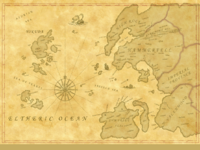
Redguards hail from the Yokudans, the humans from the western continent of Yokuda. The creation myth from The Annotated Anuad suggests that Yokuda was once a part of Tamriel during the Dawn Era, but was ripped from the mainland and became a separate landmass after a destructive war among the Ehlnofey. After this destructive war, the Ehlnofey split into many different racial and aboriginal groups. The group of Ehlnofey that remained on Yokuda eventually became the Yokudans.[9]
Yokuda would sink to the sea in ancient times, with the cause attributed either to natural factors (earthquakes, tsunamis, or volcanic eruptions) or to the revenge of a defeated band of Ansei called the Hiradirge. Upon the sinking of their homeland around 1E 792, the Yokudan fleet set sail to the east, eventually arriving in what would later be called Hammerfell.[10] The bulk of the refugees remained on the island of Herne while the Ra Gada, the Warrior Wave, continued on to mainland Hammerfell in 1E 808.[7][11] According to residents of Anvil during the late-Third Era, ships still sailed to Yokuda from Anvil,[12] and some texts referred to the continent as if it still exists in some form.[13]
Imperial scholars concluded that the term "Redguard" originated as a phonetic corruption of "Ra Gada".[7] However, Redguard myth considers it a legacy of the War of the Singers, a series of seven battles in Yokuda circa 1E 780, shortly before the continent was destroyed. Their legends say the war was fought between the army of the Last Emperor Hira and the greatly outnumbered Ansei (presumably the Hiradirge), who sought out the leadership of Lord Frandar Hunding at the onset. Hunding led the Ansei to victory using his "Hammer and the Anvil" strategy, but at great cost. Though they spared the land from Hira's tyranny, they had to leave it afterwards, for when Hunding's strategy reached fruition in the final battle (i.e., when the proverbial hammer fell), more than three hundred thousand people were killed. In the eyes of the citizenry, their guardians were red with blood. So they left Yokuda, sailing across the Eltheric Ocean, and took on new names to commemorate their final battle: their new land was Hammerfell, and their new name was the Redguards.[14][15] As Yokuda sank into the sea, the Yokudans were forced to follow them to this new land or perish.[10] For Hunding's role in leading the settlement of the Redguard people in Tamriel, he is sometimes known as the "first Redguard".[16]
These were not the first Redguards to arrive in Tamriel, however. The Silverhoof Horsemen of Rivenspire in High Rock, long thought to be a myth, were confirmed to exist by scholars in the Second Era. They are believed to have migrated there from the Yokudan island of Akos Kasaz sometime in the early sixth century of the First Era.[17] Even earlier Redguards were known to inhabit central Tamriel in the late fifth century of the First Era.[nb 1]
The Ra Gada Invasion[edit]
- →For more detailed information, see: Ra Gada
When they arrived, the early Redguards faced a Goblin invasion, but drove them away. Later when more Ra Gada arrived after the sinking of Yokuda, the Ra Gada attacked the settlements of Nedes,[18] Bretons, Mer,[19] as well as the native beastfolk and creatures.[7][19] They conscripted those they did not slay as laborers or servants for the "warrior-sailors" of the Ra Gada.[20] After only a few brutal months, the Ra Gada had established a strong presence along the western shores of Hammerfell, disrupting and replacing the Imperial and Nordic raiders who had preyed upon the area for centuries.[21] From the footholds along the coast, they continued to launch assault after assault, eventually succeeding in driving off the Orcs and making way for the High King and the Yokudan royalty, known as the Na-Totambu, to safely arrive in Hammerfell.[19] All the old cities of the Dwemer in the region, with a few exceptions, are now the cities of today's modern Hammerfell.[22]
Despite how long ago they arrived, the Redguards are still the comparative newcomers: every other modern race had already emerged before the Ra Gada arrived at Tamriel's shores.[19] And despite the advanced culture they brought with them, their martial nature and the force with which they established themselves in Tamriel earned them a longstanding reputation as barbarians and cutthroats.[7]
Later in the First Era, the Redguards came under threat from a second, seemingly unstoppable invasion of giant goblins. However, they were thwarted thanks to the leadership of Derik Hallin, who restored the teachings of Frandar Hunding and his Book of Circles, which have remained an integral part of Redguard life ever since.[22]
Foreign Relations[edit]
In 1E 948, King Joile of Daggerfall sent a letter to Gaiden Shinji of the Order of Diagna, proposing a joint attack on Orsinium. Joile cited that the Orcs were raiding along the Bjoulsae and impeding traffic to the heart of the land as reason enough to make war against them. Agreeing to provide aid, an alliance was formed between the Order of Diagna and the armies of Daggerfall and Sentinel. The armies amassed and began a 30-year long campaign for the destruction of Orc's homeland known as the Siege of Orsinium.[23][24] In that time, King Joile planned to betray the Redguards and invade Hammerfell. Joile and his Reachman general Mercedene enacted a plot to kill Gaiden Shinji and Orcish hero Baloth Bloodtusk, which succeeded, despite the efforts of Daggerfall's own Knights of the Dragon to stop the attempt and their defeat of General Mercedene.[25] In 1E 973, Joile's invasion of Hammerfell proceeded, but he was stopped by the Ansei warrior Makela Leki at the Bangkorai Pass.[26] The Siege of Orsinium finally ended in 1E 980 when the allied forces breached the city's defenses, overran it, and razed it to the ground.[24]
The Redguards initially scorned their neighbors, and didn't even trade with them until after they had proven their worth in the first Siege of Orsinium.[19][4] Their own native language, Yoku, was almost entirely replaced to help stabilize foreign trade,[7] although the language is still spoken.[27]page number They were absorbed into the Second Empire sometime during the Reman Dynasty.[7]
Second Era[edit]
In 2E 566, king Ranser of Shornhelm invaded Wayrest, furious with Emeric of Cumberland for rejecting his daughter's hand to instead wed Maraya, the daughter of King Fahara'jad of Sentinel. He was defeated at Markwasten Moor by the forces of the Daggerfall Covenant with the help of the Orcs, who were promised to have Orsinium returned for their aid.[28] The Orcs aiding King Emeric would push Ranser over the edge, and he ordered his Spymaster to round up many Orcs in Rivenspire to be interrogated and executed. The Spymaster would end up murdering hundreds of innocent Orcs throughout the course of war.[29][30]
These events led to the formation of the Greater Daggerfall Covenant, an alliance between Emeric, the Redguard king Fahara'jad and the Orcish king Kurog gro-Orsinium.[31] Trade flourished under the alliance, making the Covenant an economic powerhouse.[32] The Covenant later fought in the Alliance War during King Emeric's bid for the throne of Cyrodiil.[31] The kings of the Daggerfall Covenant looked to Reman as a model Emperor, viewing themselves as the spiritual heirs to the Second Empire.[33] Focused on restoring the glory of Reman's legacy, the Covenant cited its focus on freedom, worship of the Divines, and primacy of trade as reasons it was meant to be the center of Cyrodiil's power.[32] The strongest support for the Covenant centered in the city-states of Hallin's Stand and Sentinel, with much of the outer regions of Redguard society remaining distrustful of their new allies.[4]
Sometime during the Interregnum, the fragile administrative republic established in Hammerfell by the Second Empire collapsed, and control of the province reverted back to the traditional, hereditary monarchy of the Na-Totambu. The new High King of Hammerfell moved his seat of power from the old capital of Hegathe to the more prosperous northern city of Sentinel. This ignited tension between Forebears and Crowns, as Sentinel was a Forebear city. Upon the death of High King Thassad II in 2E 862, the people of Sentinel retook their city by force. Crown Prince A'tor journeyed to the city to seek vengeance, leading to one of the bloodiest massacres in Tamrielic history.[7] The bloody civil war that ensued led to Hammerfell being easily absorbed by the Septim Empire in 2E 864, though the Empire soon had to make some significant concessions of power following a successful revolt in Stros M'Kai.[19]
Third Era[edit]

Redguards would become more outgoing under the Septim Empire, and many branched out into other parts of Tamriel. Redguards reportedly served as mercenaries under the Camoran Usurper around 3E 267.[34]
King Camaron of Sentinel would be killed during the War of Betony in 3E 403, a short but vicious land dispute with Daggerfall over the island of Betony.[35] The aftermath brought a lot of bad blood between the Bretons and Redguards of the Iliac Bay.[36][37] Following the Miracle of Peace, Sentinel (then under King Lhotun) greatly expanded to take over the entire northern coast of Hammerfell.[19][38] The Redguards of eastern Hammerfell harbor a fierce grudge against Skyrim, yearning for a chance to take back land that was seized during the War of the Bend'r-mahk in 3E 396.[19][36]
Fourth Era[edit]
In the early Fourth Era, following the Oblivion Crisis and the destabilization of the Third Empire, the combined forces of Hammerfell and High Rock sacked Orsinium, leading many Orc refugees to flee east into Skyrim.[27]
Hammerfell was still part of the Empire when Titus Mede II ascended the throne of Cyrodiil in 4E 168. In 4E 171, the Great War erupted when the Third Aldmeri Dominion demanded, in part, that the new Emperor Titus Mede II cede large tracts of southern Hammerfell to them. The Empire fought back, and High Rock assisted Hammerfell during the Great War. The Dominion took Hammerfell's southern coastline, leaving Hegathe the lone surviving state. Those who survived the March of Thirst joined Legion reinforcements from High Rock in northern Hammerfell in 4E 173, and the Dominion suffered losses in the province soon after. The Dominion withdrew from the Redguards' home in 4E 174.[39]
Forces comprised of Redguards, Imperials, Nords and Bretons participated in the Battle of the Red Ring in 4E 175. It was the climax of the war, and the last major conflict to occur before the signing of the White-Gold Concordat. Though the rest of the Empire left them to their fate, the Redguards refused to back down and suffered mass devastation all over southern Hammerfell in their long, though successful, repulsion of the Dominion's invasion. Many Redguards remain bitter over the Empire's abandonment, believing that their triumph is proof that the Concordat was a mistake, and the Empire would have succeeded had it fought on.[39][40]
Culture[edit]
Holidays[edit]
Many of the existing holidays in modern day Hammerfell appear to originate from before the Redguard's arrival in Tamriel, some which have been changed to fit their new homeland.[11]
- Ovank'a
- falls on the 12th of Morning Star and is the day the people of the Alik'r Desert offer prayers to Stendarr in the hopes of a mild and merciful year. It is considered very holy.[41]
- Day of Lights
- The Day of Lights is celebrated on the 16th Morning Star as a holy day by most villages in Hammerfell on the Iliac Bay. It is a prayer for a good farming and fishing year, and is taken very seriously.[42]
- Aduros Nau
- On the 28th of Sun's Dawn, the villages in the Bantha celebrate the baser urges that come with Springtide on Aduros Nau. The traditions vary from village to village, but none of them are for the overly virtuous.[43]
- Festival of Blades
- Falling on the 26th of First Seed, it is a holiday created in honor of the first Redguard's victory over Malooc's Horde, an army of giant goblins that lived in Hammerfell.[44]
- Day of Shame
- Held on the 20th of Rain's Hand, all along the seaside of Hammerfell, no one leaves their houses on the Day of Shame. It is said that the Crimson Ship, a vessel filled with victims of the Knahaten Plague who were refused refuge hundreds of years ago, will return on this day.[45]
- Koomu Alezer'i
- It is a holiday held on the 17th of Second Seed and observed by the Redguards of Sentinel. It is a day made in remembrance of the city's founder, Yaghoub the Seafarer, who discovered the city's harborage on that day in the early-mid First Era by following the Steed constellation and named it after the watchman who first saw it.[20]
- Drigh R'Zimb
- This festival is held on the 1st of Mid Year, which is the hottest time of year in Abibon-Gora. It is a jubilation held for the sun Daibethe itself. Scholars do not know how long Drigh R'Zimb has been held, but it is possible the Redguards brought the festival with them when they came in the First Era.[46]
- Divad Etep't
- Held on the 12th of Sun's Height, during this holiday the people of Antiphyllos mourn the death of one of the greatest of the early Redguard heroes, Divad, son of Frandar of the Hel Ansei. His deeds are questioned by historians, but his tomb in Antiphyllos is almost certainly genuine.[47]
- Fiery Night
- Few besides the natives of the Alik'r Desert would venture out on the hottest day of the year, Fiery Night. It's a lively celebration falling on the 29th of Sun's Height, with a meaning lost in antiquity.
- Maiden Katrica
- A celebration for Katrica, a warrior-maiden that is associated with the Redguards. They often use the exclamation, "by Katrica", or "by the Maiden".[48] Many years ago, the county of Ayasofya was attacked by an unknown threat but was saved Katrica. Ever since then, on the 2nd of Last Seed, the county celebrates her victory and their salvation with the holiday, Maiden Katrica, a large celebration.[49]
- Feast of the Tiger
- Held on the 14th of Last Seed, the Feast of the Tiger in the Bantha rainforest is like other holidays in praise of a bountiful harvest. It is not, however, a solemn occasion for introspection and thanksgiving, but a great celebration and festival from village to village.[50]
- Riglametha
- Meaning "grateful-offering" in the Banthan dialect of Yoku,[51] this holiday held on the 12th of Hearthfire[51][52] and observed across the province of Hammerfell,[53] but has much more significance in the Barony of Lainlyn. It is generally a festival of the graces, which the gods have bestowed upon Lainlyn for centuries. As is tradition, performances are held to depict great moments in Lainlyn's history.
- Dirij Tereur
- Falling on the fifth of Frost Fall, it is a sacred day for the people of the Alik'r Desert. During it, they honor Frandar Hund, the traditional spiritual leader of the Redguards who led them to Hammerfell in the First Era. Stories are read from Hunding's Book of Circles, and the temples in the region are filled to capacity.[54]
- Hel Anseilak
- It is held on the 18th of Sun's Dusk. The name means "Communion with the Saints of the Sword" in Old Redguard, it is the most serious of holy days for the people of Pothago. The ancient way of Hel Ansei is never practiced by modern Redguards, but its rich heritage is remembered and honored on this day.[55]
- Baranth Do
- This holiday is celebrated on the 18th of Evening Star by the Redguards of the Alik'r Desert. Its meaning is "Goodbye to the Beast of Last Year." Pageants featuring demonic representations of the old year are popular, and revelry to honor the new year is everywhere.[56]
- Chil'a
- This holiday falls on the 20th of Evening Star and it represents the blessing of the new year in the barony of Kairou, is both a sacred day and a festival. The archpriest and the baroness each consecrate the ashes of the old year in solemn ceremony, then street parades, balls, and tournaments conclude the event.[57] The Local Iliac Bay New Year's festival is on the 24th of Evening Star, however.[11]
- New Life Festival
- During the New Life Festival which falls on the 25th of Evening Star, the Redguards of Bergama partake in the Signal Fire Sprint. A race to light several beacons around the city. This is to honor the sacrifice of an ancestor who saved Bergama from certain doom.[58]
- Serpent's Dance
- The Serpent's Dance in Satakalaam may or may not have begun as a serious religious holiday dedicated to a snake god, but in this day, it is a reason for a great street festival.[59]
Food[edit]
- →For more detailed information, see: Redguard Cuisine
The Redguards live upon the arid land of the Alik'r, which makes farming an arduous task. They allow domesticated livestock (such as goats) to graze, and their crops need to be able to resist drought. They often dehydrate or salt their food for storage and trade. Everyday meals, on the other hand, are cooked using methods that don't exacerbate the intense heat of the sun during the day: flatbreads are baked within seconds on searing hot stones instead of ovens, and pots of stew are placed over coals to cook over long periods of time. Their port cities bring in trade that adds variety to their diet, and the hot peppers that grow in their homeland are prized both by them and cooks overseas.
Language[edit]
- →For more detailed information, see: Yoku
Yoku, sometimes called Old Redguard, Old Yokudan, or High-Yokudan, was the ancient native language of Yokuda. After the Yokudan migration to Hammerfell around 1E 808, the settlers began to assimilate into the larger Tamrielic theater and the language was almost entirely replaced to help stabilize foreign trade. However, certain groups of Yokudans maintained their language and traditions outside of mainstream Redguard society. By the late Third Era, the language was still spoken, albeit rarely. There is a regional variant of Yoku known as the Banthan dialect. It derives from the eponymous region of Bantha.
Yoku has 48 different versions of the word "honor", which all trace their roots to ugak-ta.
Fashion: Armor, Weapons, etc.[edit]
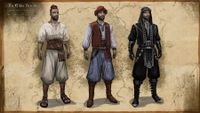
Redguards have a great diversity in styles for their clothing,[7] though it tends to be light, long, and flowing to best tolerate the heat and hazards of the desert. They first developed this style of dress in Yokuda, which was known to have arid deserts similar to the Alik'r desert of their adopted homeland.[60] The flowing curves of Redguard dress is mimicked in the designs of their armor and weaponry.[60] Imperial propaganda from the late Second Era speaks of some Redguards opting to go nude in public, particularly in Rihad.[7] Many Redguard men show an affinity for beards. "A man is only as great as the beard that wears him" is an old Redguard proverb.[61]
Denizens of the Alik'r tend to favor lightweight leather armors to better cope with heat, and often wear face coverings to keep sand from their mouths.[62] When Redguards use metal armor, they typically opt to use those with a flexible design that allows for free movement. Metal armor is clasped together as an outer skin, which wraps around the body tightly. Both armor and weapons may feature ornamentation, such as gems embedded into a cuirass, the top of a staff, or a sword's pommel. Steel and gold embossing is commonplace, and carvings of lions, horses, water, or even the god Satakal can be expected. Blunt or chopping instruments have fallen out of favor for the average Redguard, and they prefer quickness over mass for their curved swords.[63] The stone-worshipping people from Hammerfell wear porcelain armor, enchanted and blessed by the Gods through the hands of its craftsman, each scale painted by hand with ocean patterns.[UOL 1]

Redguard's Yokudan predecessors favored the sword, and like modern Redguards, believed them to be an extension of themselves.[4] The scimitars Redguards use were also used by the Yokudans.[64] Modern Redguards put elaborate patterns on their most finely forged blades which harken back to the Yokudan sword-saint traditions.[63] For the Yokudans, their swords underwent elaborate forging and reforging processes in an effort to make them nigh unbreakable. They also understood the utility of other weapons such as the axe. Ranged weapons were seen as less honorable, but archers and the rarer war-wizards could also been seen in their ranks. Spellcasting staves were modeled to look like melee weapons to borrow some of the prestige melee combatants basked in.[65] The material orichalcum held a special religious significance to the ancient Yokudans, believing that the god Diagna intervened by bringing orichalc weapons to them during their war with the Lefthanded Elves, granting them victory.[66][67] The modern Redguard's jewelcrafting methods have remained largely unchanged from their ancient ancestor's time in Yokuda. The Yokudans had a wealth of options for precious gemstones to mine from back in their western continent, allowing them to refine their gem-cutting traditions even in spite of near-constant civil wars causing a shift on focus for utility over beauty.[68]
The second Warrior Wave, or "Tavan" wave, so-called because it was spearheaded by the Hattu Metropoles brigade, which revered Tava greatly, had their arms and armor repleted with bird imagery.[69][70] The Redguards swiftly adapted the claymores of the Bretons to their own style of fighting.[71]
Domesticated Animals[edit]
In the desert wastelands of Hammerfell, the most common mount used by the Redguards is the camel, which they count on to survive.[72] Camels are used as military mounts, as civil mounts and as livestock, from which locals obtain its meat, hide, and milk.[73][74] White camels are said to be sacred to Zeht, the Redguard god of food and farming. The devout folk of Hammerfell bow when one rides past.[75] Dervishes of Rihad are a faction of talented and religious sword dancers that shave their camels and tattoo them with mystic symbols so that spirits of the deep desert would not lead them astray.[76]
Redguards have a great affinity for horses, and brought many with them to Hammerfell.[17] The most notable among these steeds are the Yokudan Chargers, a breed found in the Alik'r Desert of Hammerfell.[77] They are descendants of the gray Yokudan Warhorses brought from Yokuda by the Ra Gada.[78][79] These horses are exceptional for their ability to traverse the Alik'r Desert's terrain, unlike other horse breeds. They are also the primary steed of choice for the Gallants of Hammerfell, the Redguard-equivalent of knights of the province.[77]
The Alik'r Dune-Hounds are a lean, short-haired breed commonly owned by Redguard hunters from the Alik'r. As they are very reliable trackers, hunters describe the feeling of hunger with the saying "as starved as a hunter with no Dune-Hound".[80] The roving Redguards of Hammerfell's canyon badlands have bred local painted wolves into mounts capable of going through the broken terrain that camels struggle to navigate through.[81] The Redguards of the secretive Pyre Watch have domesticated and bred jackals for use as mounts.[82]
Fennec foxes are revered as creatures that thrive in the harsh conditions of Hammerfell, and have been domesticated and make alert companions. They have been adopted as the symbol of the Moguls of Taneth, whose cavalry rides under a fennec fox banner.[83][84] In Sentinel, wearing ornate masks depicting these animals was popularized by King Fahara'jad.[85]
Dragon Frogs are commonly kept as pets in Hammerfell for their striking appearance and pest control attributes, particularly the kindlespit and blue oasis variants. Stories in Hammerfell claim that they were once dragons before being transformed.[86][87]
Sep adders are venomous winged snakes often described as having a mean temperament and short tempers, like badgers in snake-form. However, this has not stopped people from attempting to tame these reptiles as pets.[88] Aside from the common sep adder, there are a few known subspecies; the cobalt sep adder is rarely seen in captivity but is prized among the Hammerfell nobility for its rumored ability to be able to detect poison in drinks and food.[89] Another variety, the silver-scaled infernal sep adder, is known to inhabit the high altitudes regions of Hammerfell.[90]
The giant, dangerous, and untamed assassin beetles were once the domesticated Samara scarabs native to Yokuda. There, they were a popular family pet the size of a loaf of bread, and were brought to Tamriel when the early Redguards fled from Yokuda. However, once on Tamriel they began to continue growing to monstrous sizes as they matured, forcing the early Redguards to drive the beetles from their homes and into the wild, where they flourished and became the baneful assassin beetles. To the Redguards, this transformation represented a lesson from the gods; they believe the Samara Scarabs were smitten by the Hunger of Sep, to teach even the youngest child a valuable lesson about the dangers of their new home on Tamriel.[91]
Architecture[edit]
Redguard buildings vary from simple tents to the sturdy domed structures of the cities which incorporate many Yokudan advancements. The latter are renowned for their rigidity, flexibility, heat transference, and general ornate beauty. They are much easier to repair than most Imperial stonemasonry. While much Imperial construction requires demolition and rebuilding after conflict, many of the Yokudan accent pieces, such as the flying staircases or ornamental domes, are designed to crumble after an attack or an earthquake, which allows them to be easily replaced in sections afterward. However, these structures are still solidly built; they stand tall and firm against the harsh environment of Hammerfell.[4] They are characterized by thickly-built walls to help insulate against the heat of the desert, as well as a carefully-planned system of ventilation ducts. These ducts are built alongside windows high on the walls, and are covered by horizontal slats which keep out the sun while permitting the wind to enter. Each building is designed to channel even the slightest breeze from these ducts down to the floor.[60]
Redguard stables have been recognized for their lavishness and the ingenious design which makes them perfect for the environmental hazards the Redguards face. Their enormous mausoleums are thought to be the purest, undiluted representations of Yokudan architecture in their society. The most famous example, Tu'whacca's Throne in the Alik'r, is also a monument to the many Yokudans who died when the continent was destroyed, and it receives many pilgrims seeking to pay their respects.[4]
They Redguards employ johads to collect water in places where the resource is scarce. Johads are simple but effective water collectors made of sticks and fabric which gather the desert's morning dew.[92]
-
Redguard architecture circa 2E 582
Society[edit]
Like all races, Redguards have been shaped by their home. Since their arrival, they have been few in number, relative to the other races of Tamriel.[4] Their Yokudan heritage left them with advanced seafaring, agricultural, military and even astronomical knowledge that allowed them to thrive in a place where others merely hoped to survive. Redguard society is extremely martial, and nearly everyone is expected to have a grasp of basic weaponry and combat, although only the rulers are generally expected to have detailed knowledge of strategy, formations and tactics. Only the strongest, fastest and smartest Redguards are accepted into the demanding military (which consists mainly of various knightly orders; Redguards don't traditionally have a standing army), and they are expected to prove themselves worthy by facing death.[7] Even their entertainment, like snake charming, bears some risk to it.[93]
They are a highly disciplined and enterprising people, having centuries of experience with warfare in their homeland before arriving on Tamriel's shores. Their warriors are acknowledged as among the best in the world. The Redguards are also known for their naval prowess, and their fleets have proved to be a match for the Empire's best armadas, a fact demonstrated during the Stros M'Kai revolt.[94] Stros M'Kai and some parts of mainland Hammerfell hold many Dwemer ruins, and some young Redguards seeking to enter military service must brave the dangers of these ruins to prove themselves.[7] Most of their holidays and traditions seem to revolve around either the celebration of natural phenomena or the commemoration of great battles and warriors.[11][14][95] The constellation of the Warrior and its charges seem to be of great importance in their ancient literature.[96][97]
Redguards were known to be able to harness the powers of the air and sand associated with deserts. Magic wielded by Alik'r wizards was focused into reflection and purpose. Shifting sands and air are one of the key components not only of the desert, but of its natural magics.[98] However, the practice of magic has generally been frowned upon since the First Era,[99] and outsiders are not tolerated in many parts of Hammerfell.[7][4][100] Many believe that no "true" Redguard would stoop to using magic, considering it a weakness.[101] Certain schools that teach the Way of the Sword forbid students to use magic and enchanted weapons.[102] By the Third Era, spellcasters were shunned in Hammerfell, with many believing them to be wicked individuals who steal souls and tamper with minds.[103] Necromancy has always been abhorred in Redguard culture due to their reverence for the dead. Although the Redguard suspicion of magic is regarded as a hallmark of their culture, it was not always so pronounced: in ancient times, Yokudan war-wizards were part of their armies, albeit rare.[65] Sword-singers were said to have forged swords woven with magic, and indeed the Shehai itself is believed to be a form of magic.[14]
Redguards have engaged in cultural exchange with a variety of other races. Carlovac Townway (author of 2920, The Last of the First Era) once asserted that Redguard culture and their greatest heroes have been heavily influenced by Akaviri and Tsaesci culture, specifically citing Gaiden Shinji of the Order of Diagna as an example of this cultural exchange.[UOL 2] The Redguards also adopted some of the religion, customs, and language of the Nedes they annihilated.[7] Around Redguard cosmopolitan coastal cities, the inhabitants have adopted Breton and Imperial influenced fashion and architecture with a blend of Yokudan flair.[7] The two races the Redguards are closest in proximity to, the Bretons and the Orcs, are their historical enemies:[2] however, they have allied with each other at times.
Stuffed lizards are common gifts for children. They're sometimes made to wear little tailored clothes.[104]
Forebears and Crowns[edit]
The social strata of the Redguard has long been fractured.[4] When Hammerfell became a province of the Second Empire and demarcated in the Imperial custom, Redguard society was formally divided into two main socio-political groups: the Crowns and the Forebears.[7] The Crowns are descended from the High King and the Na-Totambu who ruled in Yokuda; they hold Yokudan tradition in high reverence and greatly dislike foreigners. Their influence has been waning since the last High King perished in 2E 862 and his son, the Crown Prince A'tor, reacted by viciously butchering the Forebear citizenry. When Tiber Septim's forces conquered the land two years later, it was perceived as a humanitarian gesture to stop the senseless bloodshed.[7] While the intervention did cease open war, the hostility between the various regions of the province remains so great that some have been known to ignore their brethren when they're trying to repulse a foreign invasion.[19]
The Forebears are descended from the Ra Gada warrior class which conquered the province, and in so doing were exposed to many Nedic (and later Breton and Imperial) traditions and ideas, while the ancestors of the Crowns were not. The Forebears seek modernity; they are more cosmopolitan than their Crown counterparts and more welcoming of foreigners and different ways of life. They have adopted modified Imperial and Breton styles for their dress, architecture, and names, and many have even reorganized their traditional gods and spirits to fit into the Imperial pantheon of the Divines. Forebears are generally predominant in coastal cities and other major trade centers in the north, while most Crowns live in more secluded regions in the south, notably the deserts and other inhospitable areas.[7][4]
In the late Third Era, a third faction emerged. Named the Lhotunics after their founder King Lhotun, they espouse the progressive and cosmopolitan values of the Forebears while maintaining a strong respect for their past, though the specific compromises are not known.[19] The movement is largely political: the Forebear kingdom of Sentinel is uniquely well-suited to forge a compromise between the two Redguard factions because it has been a seat of both Forebear and Crown power, and its economic and military strength has made it one of the most powerful and respected kingdoms in all of Tamriel.[7][19] Since the Miracle of Peace and beyond, the Lhotunic movement has served as a unifying force for Sentinel as it gains dominion over more territory, and since much of that territory is dominated by disgruntled Crowns, the necessity of the Lhotunic movement is apparent. Due to their moderate platform and these expansionist policies, the Lhotunics are generally disliked by the remaining Forebears and Crowns.[19] However, the events of the Great War reportedly led to a reconciliation between the two factions.[39]
Lhotunics[edit]
The Lhotunics are the third faction in Redguard society that appeared after the Warp in the West. During the Warp, the Forebear city of Sentinel became the dominant power in most of northern Hammerfell. However, most of Sentinel's new lands were Crown. To keep his kingdom together, King Lhotun was forced to create what some consider a third party, one with reverence for the Yokudan past but respect for the Imperial ways. The moderate Lhotunics have attracted nothing but contempt from both the Forebears and the Crowns.
Ash'abah[edit]
The Ash'abah (roughly translated as unclean people) are an ancient and secretive tribe of Redguards who inhabit the northern wastes of Hammerfell, roaming the Alik'r Desert. They are shunned by Redguard society due to their "unclean" interactions with the risen dead, as they disregard religious taboos and destroy the undead, slaying with great skill what might be honored ancestors returned.
Against the widespread distrust of magic, the Ash'abah perform rituals of purification for mausoleums and other places where vengeful spirits might arise, including an annual ceremony at Tu'whacca's Throne meant to ensure the rest of the ranks of Redguard royalty. This activity is regarded as blasphemous, but tolerated due to the necessity of its performance. The Ash'abah considers the body to be sacred. If one ever becomes corrupted by necromancy, they strive to preserve the body while banishing the unholy essence. To achieve this, they have developed highly ritualistic methods of killing that involve uttering pleas of forgiveness and apology.
Exiled Sun-Eaters[edit]
The Exiled Sun-Eaters of Numaneh were an exiled tribe of Redguards. Little is known about them, and as of 2E 582, telling their tale was forbidden according to the Unveiled Azadiyeh, the Songbird of Satakalaam, a storyteller, expert in old Redguard lore, and a follower the original Yokudan pantheon. They were listed alongside the Ash'abah and Silverhoof Horsemen in response to the question about various isolated Redguard communities and tribes.
Silverhoof Horsemen[edit]
The Silverhoof Horsemen (also known as the Horse-Folk of Silverhoof, or simply Horsemen) are a tribe of Redguards abiding in the pastoral basin known as the Vale of Silverhoof. Described as horse nomads, the Horsemen take care of horse herds as their livelihood, and also train steeds for others in exchange for goods. The Horsemen venerate a divine animist spirit they call the Herd Mother.
Sword-Singers[edit]
Sword-singers (or Sword Singers) were an order of Yokudan warriors who followed the "Way of the Sword", a martial philosophy on blade mastery. Singers were capable of astonishing feats of swordsmanship, and were viewed by some to be as much mages as warriors. They sought strength of body, and of mind. Although the tradition of sword-singing originated in Yokuda, it was brought to the shores of Tamriel by the Ra Gada in the First Era. The sword-singers were instrumental in claiming the entire province of Hammerfell and establishing a new homeland for the Yokudan people. The Ansei (or Sword Saints) were the greatest among them. The most accomplished sword-singer in history was Frandar Hunding, whose writings on the subject were revered by the Redguards centuries later.
Gallants of Hammerfell[edit]
The Gallants of Hammerfell (also called the Knights of the Desert, or simply Gallants) are expert sword-wielding warriors and horse-riders from the province of Hammerfell, specifically the Alik'r region. A gallant's main choice of steed is the Yokudan Charger, a breed of horse that can traverse the Alik'r Desert better than other breeds. Gallants have several chapters across the Alik'r Desert and are based in the region's various cities, such as Sentinel and Bergama. "Gallants" are the Redguard equivalent of the Tamrielic knight, and Stendarr, the Forebears god of justice is their favorite deity.
Religion[edit]
Redguards have come to venerate different gods, with the Crowns sticking to the most ancient Yokudan pantheon, while Forebear beliefs have evolved to include many Imperial influences. Many of the Crowns are nomadic tribesman who mainly travel around the Alik'r, and though they adhere to traditional Yokudan beliefs, they have also developed a deep, spiritual attachment to their adopted land. They venerate deities and spirits of all kinds, from Pixies (or faeries) to Satakal the Worldskin, the god of everything (a sort of fusion of Anu and Padomay that bears similarities to the malevolent Nordic god Alduin).[7][105][106][107] Occasionally, Satakal will destroy everything to begin anew, and the spirits who manage to find a way to survive are those who can move at "strange angles" to stride between one world and the next, and thus enter the Redguard pantheon of gods.[108]
The Silverhoof Horsemen tribe of High Rock have substantially different religious beliefs than their brethren. They venerate a divine animist spirit they call the Herd Mother. Their tradition holds that they left Yokuda in order to freely worship this equine deity.[17]
Crown Gods[edit]
The Crown pantheon includes Satakal and the chieftain Ruptga, or Tall Papa, the first to survive Satakal's destruction. They also venerate Zeht (Yokudan God of Farms), Tall Papa's favorite wife Morwha, Tava (considered equivalent to Kynareth), Onsi (a god of war), and Diagna. Tu'whacca was thought to be the god of "Nobody Really Cares" before the creation of the world, when he became a caretaker and protector of souls (similar to Arkay).[109]
Satakal
Satakal the Worldskin, also called the First Serpent, Serpent God, and the World-Snake, is the Yokudan god of everything, and a fusion of the concepts of Anu and Padomay (Satak and Akel), or the habitable universe resulting of their interaction, also called the Aurbis or "The Gray Maybe". They can be considered analogous to Akatosh in a way, being the first being "born" from the interplay of the original forces. Driven by hunger to eat one world to begin another, Satakal also has much in common with the Nordic Alduin. In Yokudan mythology, Satakal has done (and still does) this many times over, a cycle which prompted the birth of spirits that could survive the transition, notably Ruptga, the first who learned how to do so. These spirits ultimately became the Yokudan pantheon.
Satakal is a popular god of the Alik'r nomads. Redguard creation myth holds that they are doomed to mortality because they are very far away from the real world of Satakal, and the safe haven of the Far Shores is too far away for them to jump from the mortal world.
Ruptga
Ruptga, more commonly Tall Papa, is the chief deity of the Yokudan and Redguard pantheon. He was the first god to figure out how to survive the Hunger of Satakal.
Onsi
Onsi (also known as the Boneshaver), is a notable warrior god of the Yokudan Ra Gada and a part of the Redguard Pantheon. Onsi is said to have taught Mankind how to pull their knives into swords. He is mentioned several times in The Book of Circles by Frandar Hunding, who wrote that those forging a sword should recite the "Oblation of Onsi" upon completion. A tale of King Fahara'jad's youth claimed that Onsi personally saved him from a vengeful hagraven.
Diagna
Diagna, (also known as the Orichalc God of the Sideways Blade) was an avatar of the HoonDing (the Yokudan God of Make Way) that achieved permanence as a Redguard sword-god. His "hoary thuggish cult" originated in Yokuda during the Twenty Seven Snake Folk Slaughter. He was instrumental to the defeat of the Lefthanded Elves, as he brought orichalc weapons to the Yokudan people to win the fight. According to one myth, Diagna crashed his fist against the HoonDing Gong and swords fell from the walls of the Orichalc Tower.
In Tamriel, he led a very tight-knit group of followers, called the Order of Diagna, against the Orcs of Orsinium during the height of their ancient power, but then faded into partial obscurity. He is described as now being little more than a local power spirit of the Dragontail Mountains but he is still worshipped as of the 4th Era, being part of the Eight of the Crowns.
High Kings of Hammerfell are crowned on the Throne of Hegathe by wearing the Diadem of Diagna. Warriors of the Order of Diagna carried stone effigies of Diagna during the siege. The Daggerfall Covenant's alliance of the Orcs and Redguards was alleged by the Unveiled Azadiyeh to have inflamed Diagna's very sword-arm with the Crimson Rash of Betrayal.
Forebear Gods[edit]
The Forebear belief system includes several of the Nine Divines recognized by other cultures: Akatosh, Julianos, Dibella, and Stendarr. However, it is often unclear if they have the same understanding of these deities that others possess, as they often use a name of one of the Divines when referring to a Yokudan deity. For instance, they continue to venerate the Bird God Tava, a favorite among many Redguard sailors, but they have been known to call her Kynareth. Similarly, they may refer to Tu'whacca as Arkay, Zeht as Zenithar, and the four-armed fertility goddess Morwha as Mara.[109][110]
Akatosh
Akatosh is the Dragon God of Time who is present in most religions in Tamriel.
Julianos
Julianos, Aedric God of Wisdom and Logic, is one of the Cyrodilic Divines, governing the realms of literature, law, history, and contradiction. He is usually associated with magic, and thus is often revered by wizards. Jhunal, the Nordic father of language and mathematics, fell out of favor in the Nordic pantheon, after which he became Julianos of the Divines. Monastic orders founded by Tiber Septim and dedicated to Julianos are the keepers of the Elder Scrolls. He is particularly venerated among many Imperials and Bretons, but he also sees worship among the Forebear Redguards. As a Divine, he represents the virtue of learning, scholarship, and justice. His domains include sorcery, alchemy and enchantment. He is said to "incant the Damned Equation". His symbol is a triangle.
Dibella
Dibella, also known as the Passion Dancer, Our Blessed Lady, and simply, the Lady, is the Goddess of Beauty, Love, and Affection. She is also acclaimed as the Lady of Love, Beauty, Art, and Music. Dibella is the Queen of Heaven, and is one of the Divines.
Stendarr
Stendarr, also known as Stendarr the Steadfast, is the God of Mercy, Charity, Well-Earned Luck, and Justice. He is also acclaimed as the God of Compassion, and Righteous Rule by Might and Merciful Forbearance. Stendarr is the Apologist of Men, patron of the Imperial Legion, magistrates, rulers, and knights errant, and one of the Divines.
Both Pantheons[edit]
Both the Crown and the Forebear pantheons can overlap, such as with the gods below.
Tava
Tava (the Bird God, also known as the Lady of the Air) is the spirit of the air and goddess of weather in the Redguard pantheon, and has dominion over all elements of sun and storm, save only for the stars, which belong to Ruptga. Tava is most famous for leading the Yokudans to the isle of Herne after the destruction of their homeland. She has since become assimilated into the mythology of Kynareth. She is still very popular in Hammerfell among sailors, and her shrines can be found in most port cities. In the mid-Second Era, the city of Lainlyn was called "Tava's Blessing" before being renamed after the Lainlyn family.
Tu'whacca
Tu'whacca (or simply Tuwhacca), the Tricky God, is the Yokudan God of Souls (or Shepherd of Souls), and the Caretaker of the Far Shores. Before the creation of the world, he was the god of Nobody Really Cares. When Tall Papa undertook the creation of the Walkabout, Tu'whacca found a purpose: he became the caretaker of the Far Shores, and continues to help Redguards find their way into the afterlife. His cult is sometimes associated with Arkay in the more cosmopolitan, Forebear regions of Hammerfell, where the names Tu'whacca and Arkay are basically interchangeable. Crowns detest this Imperialization, considering it a betrayal of their heritage. Nevertheless, scholars cannot help but note the clear similarities between them, as well as the similarities they both share with Xarxes of the Altmer, in both the etymology of their names and the divine roles they fill.
Morwha
Morwha, (also called the Teat God, Lady Morwha, and Desire's Root) is the Yokudan goddess of fertility and love. She is a fundamental deity in the Yokudan pantheon and is the favorite wife of Tall Papa. Morwha is always portrayed as four-armed, so that she can 'grab more husbands'. Her shrines are the shape of a beehive. She was described by potentate Versidue-Shaie as the lusty fertility goddess of the Yokudans, but not as lusty as Dibella. She is sometimes depicted alongside her winged guardians, or surrounded by flames and spears.
Zeht
Zeht, Yokudan God of Farms, is the Yokudan god of agriculture, civil law, mathematics, and food, but he still finds a place in the pantheon of the Crowns. He is similar to Zenithar, and sometimes worshiped in that name by the Forebears. He renounced his father after the world was created, which is why Ruptga makes it so hard to grow food. He is the father of Zeqqi. He forsakes the land of Hew's Bane, preventing most food from growing there. Occasionally farming utensils of the Zeht's faithful such as digging spades are decorated with semi-precious stones and blessed by a priests of Zeht. The white camel is believed to be sacred to Zeht and pious Redguards tend to bow to passing Cloud Camels.
Other Gods[edit]
There are several other deities with significant Redguard cults among both Crowns and Forebears. Leki, the Saint of the Spirit Sword and divine daughter of Tall Papa, is credited with helping the Yokudans before their war against the Lefthanded Elves in the Mythic Era. The HoonDing, the Make Way God, is the Yokudan spirit of perseverance over infidels, and is said to materialize when the Redguard need to "make way" for their people. They believe this spirit appeared twice during the Ra Gada invasion.[109]
There is also the "Horde King" Malooc, an enemy of the Ra Gada who led goblins against them in the First Era.[109] And finally, Sep, believed to be the Yokudan variant of Lorkhan. Sep was a "crazy" merchant god who convinced the others to create the mortal world to make it easier for more spirits to survive Satakal's inevitable onslaught. Except it didn't make it easier; rather, the mortal plane acted as a trap which made apotheosis even harder.[107] In this way, the Redguard view of creation has more in common with the Elven tradition than that of other humans, who view the mortal plane as a blessing.[108]
HoonDing
The HoonDing, also known as Hoonding or The Make Way God, is the Yokudan spirit of 'perseverance over infidels'. The HoonDing has historically materialized whenever the Redguards need to 'make way' for their people.
Ius
Ius the Extremely Agitated, God of Animals is represented by statues in certain parts of Hammerfell and has strange stories regarding his origins. He is often depicted holding a large set of scales, but his worshippers have no idea, nor care to know why.[111]
Leki
Leki, also known as the Saint of the Spirit Sword is the goddess of aberrant swordsmanship and divine daughter of Tall Papa, who is said to reside in the Far Shores. She is said to be one of the most popular gods in Hammerfell.
The Na-Totambu of Yokuda warred to a standstill during the mythic era to decide who would lead the charge against the Lefthanded Elves. Their swordmasters, though, were so skilled in the Best Known Cuts as to be matched evenly. Leki introduced the Ephemeral Feint (a Sword-Singing technique, acording to some stories); afterwards, a victor emerged and the war with the Aldmer began. According to legend, one of Leki's miracles resulted in the founding of a settlement in the Alik'r. Leki's Blade was established after she dueled with Rada al-Saran, a great warrior who claimed to match the gods in the way of the sword. Sai Sahan came from a long line of Redguard swordmaster nobles, and was "something more than mortal man", descending from Leki the Yokudan Sword-Saint.
Malooc
Malooc, the Horde King, is an enemy god of the Redguards. Some scholars believe Malooc is merely Malacath in disguise, as they appear "similarly boorish" and share many "graceless aspects". These beliefs caused tensions within Hammerfell in the Second Era, as some clerics began to question their alliance with the Orcs as part of the Daggerfall Covenant.
Reymon Ebonarm
Reymon Ebonarm is the God of War, a deity of some significance to the Redguards. He was possibly originally a Yokudan deity or group of deities who may simply be manifestations of the HoonDing which have subsequently individualized.
Sep
Sep, also known as the Second Serpent, is the Yokudan and Redguard version of Lorkhan. He is said to have been created by Ruptga.
Zeqqi
Zeqqi, known as the Madonna of Tears, is a water goddess and the daughter of Zeht. As her father forsakes Hew's Bane, the water goddess takes pity on the lost souls who call Abah's Landing their home. It is theorized that the "Lady in the Cistern" statue depicts her, recognizing the sacrifices she makes to sustain the people of the city, hidden from the gaze of her disapproving father.
Ancestor Worship[edit]
—The Improved Emperor's Guide to Tamriel
- →For more detailed information, see: Redguard Ancestor Worship
The origins of Redguard Ancestor Worship is unclear. Some believe this ancient tradition began after the Yokudans settled in Hammerfell. They noticed that corpses decomposed very slowly in the desert, and over time the people assigned a spiritual significance to the process and declared that the remains of their ancestors were sacred.[112] Other sources claim Ancestor Worship was the most sacred law and tradition of the ancient Yokudans.[113]
Redguards are famous not just for their many religious rituals surrounding the dead, but also for the elaborate necropolises they build to house them. At these sacred sites, supplicants give prayer not just to their own direct ancestors, but also historical Redguard kings and the untold number of Yokudans who perished when the continent sank.[114]
The Far Shores[edit]
The Far Shores, also called the Far Dunes, is the afterlife sought by the Redguards. According to Yokudan myth, Satakal, the serpentine God of Everything, eats itself over and over, periodically consuming all of creation. By "moving at strange angles" to stride between "worldskins", a process known as the Walkabout, the strongest of the spirits learned to bypass this cycle of destruction. Thanks to Ruptga's guidance, many weaker spirits were able to find their way as well, and the practice became so easy that it became a place—the Far Shores. Here, the spirits can safely wait until Satakal has passed and a new skin has emerged. There is no hunger or thirst in the Far Shores, but there are ample martial challenges to keep Redguard warrior-spirits engaged for eternity.
Death[edit]
- →For more detailed information, see: Redguard Death Beliefs
When a Redguard dies, priests typically perform a consecration ritual in the name of Tu'whacca at their funeral.[115] Some also practice mummification of the dead. The body is laid on a table and washed in oils and leaves. Before the head and torso are carefully cut open, the body is drained of blood, and the brain, heart, and other organs are placed into ceremonial jars, followed by a week of chanting prayers, mourning, and swathing the corpse with long ceremonial bandages. The body is then interred in a painted sarcophagus within a subterranean tomb, along with the deceased's favorite weapons, servants, and pets. It's not unusual to find that their crypts and tombs can be even larger and more elaborate than their homes for the living.[116] This is all symptomatic of a Redguard respect for departed relatives, a respect so fervent it is similar to the ancestral worship of some other cultures.[4]
Though the Redguards abhor necromancy, their religion has also led them to abhor any sort of interaction with the undead.[117] Tradition bound them not to fight the honored dead, making them particularly vulnerable to necromancers and undead creatures.[118][119] Such was the importance of this ideal, that the culture of the Alik'r evolved around it. However in later years many realized that exceptions must be made.[120] One example is the Ash'abah, a tribe of Redguards who have made it their duty to purify mausoleums and destroy the undead wherever they may be found. As a result, they have been shunned from Redguard society, and are exiled to live as nomads in the wastes. Their existence is nevertheless tolerated due to the necessity of their role. Among their other traditions, Ash'abah tribesmen travel to Tu'whacca's Throne annually to perform the 36-hour-long Rite of Royal Rest, which is said to seal departed monarchs in their tombs and keep their spirits happy.[4] Another form of protection against necromancy was the creation of the Ansei Wards. These ancient relics were forged as part of a covenant with Tu'whacca to ensure that the consecrated dead could not be raised by even the most powerful necromancy.[115]
The Book of Circles[edit]
- Train your opponent to make the wrong response. — The Book of Circles
The Book of Circles was written by Frandar Hunding, a spiritual leader of the Redguards, in order to pass on his insights. When he was thirty years old (around 1E 750), he retired to a cave and began writing what would become the Book of Circles.[15] For Redguards, it is an enormous part of their culture and everyday life.[14][121][122] Reading from it was abandoned sometime later in the First Era until Hallin, the only Ansei at the time, brought back the "old ways" and told each warrior to read the book.[22] The people of the Alik'r celebrate "Dirij Tereur" every year on the 5th of Frost Fall, a holiday honoring Frandar Hunding, and festivities typically include readings from the book.[123]
Each household in Hammerfell has an alcove by its hearth just big enough to hold a copy of the Book of Circles in honor of Hunding.[14][121] The book is still highly regarded as a treatise on blade mastery and even other experts at the skill refer to it. It is said to include "thirty-eight grips, seven hundred and fifty offensive and eighteen hundred defensive positions, and nearly nine thousand moves essential to sword mastery".[124] Though they utilize many other types of arms, a Redguard's sword is considered an extension of his soul and a symbol of honor, and their mastery of blade crafting is unparalleled.[4]
Artifacts[edit]
Aurbical Abacus[edit]
The Aurbical Abacus was an ancient Yokudan relic created by distilling the knowledge and wisdom of twenty generations of the priest-wizards of the Yokudan god Zeht. It had the physical appearance of having glass gears and ivory pistons, and suffused with the blue glow of star-magic. It was used to track the movements of the moons, constellations, and planets and calculate the exact turn of the seasons. It detected the directional origin of star-magicka, or "varliance," and stored it as data. It can also predict the weather and even control it on a continental scale. It was brought to Hew's Bane after Yokuda sank, by the Zeht priesthood, where it was buried in the old Hubalajad family tomb known as Bahraha's Gloom.
Ansei Wards[edit]
The Ansei Wards were three ancient Redguard relics that contained the spirits of powerful Ansei warriors. They were created in the First Era to combat against the threat of necromancy in the Alik'r Desert. It is believed that the Ansei forged the wards from their own shehai. According to some scholars, these treasured relics have played an important role throughout the history of the Alik'r. The Wards themselves take the form of large ornate golden scimitars encrusted with gemstones.
Boneshaver[edit]
Boneshaver is a legendary saber named after the warrior god of the Yokudan Ra Gada, Onsi the Boneshaver. Onsi himself is rumored to have gifted the saber to the Ra'gada. Its blade is noted as being sharp enough to be able to cut through any foe.
The saber's physical features are ornate with dragon imagery. Its pommel is shaped like a dragon's head, and has areas on the saber's hilt that resembles scales. The blade itself features a pattern akin to that of flowing water.
Soul Sword[edit]
The Soul Sword is a shimmering longsword imbued with the soul of Prince A'tor following his death in 2E 864. Aside from being a powerful weapon, the sword can move of its own accord and allows A'tor's spirit to communicate with the wielder. Originally the royal sword of A'tor, it was enchanted with his soul during an attempt to resurrect him, and was wielded by Cyrus the Restless during the rebellion against the Imperial forces of Amiel Richton. This unity of A'tor, Cyrus, and the sword is considered to be an occurrence of the HoonDing. It was thereafter put in the possession of Iszara, Queen-Regent of Hammerfell.
Gallery[edit]
Appearances[edit]
Miscellaneous[edit]
Notes[edit]
- According to Michael Kirkbride, his writings on the Redguards and Hammerfell were inspired by the Black Panthers and the idea of reverse/black imperialism.[UOL 1] Additonally, common Redguard names, as well as certain aspects of their culture and tradition, were inspired by the real-world cultures of the Caribbean, the Middle-East, and North Africa.
See Also[edit]
- Redguard Names
- For a list of notable Redguards, see here.
- For game-specific information, see the Arena, Daggerfall, Battlespire, Morrowind, Shadowkey, Oblivion, Skyrim, Elder Scrolls Online, Legends, Blades, and Castles articles. Also see the Redguard category.
- The spin-off game The Elder Scrolls Adventures: Redguard was set in Stros M'Kai and featured the Redguard mercenary Cyrus as its main character.
Books[edit]
- Alik'r Survival for Outsiders — Advice for traveling through the Alik'r Desert
- The Ballad of Navid the Singer — A ballad of a love-scorned sword-singer in the days of the Ra Gada
- Blasius' Unfinished Manuscript by Blasius — Notes denouncing Yokudan brutality and Emperor Tarish-Zi
- Blessed, Blessed Satakalaam by The Unveiled Azadiyeh, Songbird of Satakalaam — An ode to the Yokudan pantheon
- The Book of Circles by Frandar Hunding — Proverbs on the creation and use of swords
- Crafting Motif 6: Redguard Style by Doctor Alfidia Lupus — Notes on materials and motifs used with Redguard armor
- Daily training regimen of Harayya, sword-adept instructor by Harayya — The schedule of a sword master
- Discussion with Abal at-Inzil, priest of Tava by Abal at-Inzil — A Redguard priest's concerns of allying with the Orcs
- Divad the Singer by Destri Melarg — The early years of Divad the Singer
- Epode of the Ansei Wards by Weltan of Sentinel — A poem on the self-sacrifice of three Ansei
- A Forebear Warrior's Song — A traditional Forebear song
- From the journal of Guradai, apprentice smith by Guradai — An Orcish smith's thoughts on apprenticing under Redguards
- From The Memory Stone of Makela Leki by Makela Leki — A record of the memories of Makela Leki, a Redguard warrior and master of Ansei
- From the notes of Verbaud Derre, architect by Verbaud Derre — Notes on Redguard architecture and its Yokudan roots
- Hags, Harpies, and Hagravens by The Unveiled Azadiyeh, Songbird of Satakalaam — A rebuttal against the argument of the inherent wickedness of womanhood
- Holidays of the Iliac Bay by Theth-i — An overview of Breton and Redguard holidays commonly celebrated in the Iliac Bay region
- The Horse-Folk of Silverhoof by Doctor Nabeth al-Gilane, Khefrem Academy of Yokudan Heritage — On the lost tribe of Yokuda, the Horsemen of High Rock
- How the Yokudans Chased the Stars — The legend of the Star Man and his relationship to the Warrior constellation
- The Hunger of Sep by The Unveiled Azadiyeh, Songbird of Satakalaam — On the dangers of the Hunger of Sep
- Knowing Satakal — Seven Redguard Maxims
- Letter from Alumezi, Dominion spy by Alumezi — Notes on a possible method to driving the Daggerfall Covenant apart
- The Lost Islands of Old Yokuda Attributed to Hazadiyya Sea-Queen — A poem dedicated to the islands of Yokuda
- The Manifesto of Make Way — A call for Redguards to expunge weakness from their hearts
- The Na-Totambu of Yokuda — On the lost wisdom of Yokuda
- Notes of Adalabar, hunter by Adalabar — The field notes of a duneripper hunter
- Notes For Redguard History by Destri Melarg — An unmailed letter from an author to his publisher
- On the Immortality of Dust by Weltan of Sentinel — A Redguard Poem
- Pocket Guide to the Empire, 1st Edition: Hammerfell — Imperial Geographical Society, 2E 864
- Pocket Guide to the Empire, 3rd Edition: The Ra Gada: Hammerfell — Imperial Geographical Society, 3E 432
- Redguards, History and Heroes by Destri Melarg — A summary of Redguard history, focusing on Frandar Hunding
- Reverence for the Dead by Brother Opilio Congonius — A brief essay on Redguard burial traditions and Tu'whacca's Throne
- Sacrilege and Mayhem in the Alik'r by Doctor Tazhim of the Bureau of Outlander Affairs — A Report to the Royal Family of Hegathe
- Sentinel, the Jewel of Alik'r by The Unveiled Azadiyeh, Songbird of Satakalaam — Yokudan legend surrounding the establishment of Sentinel
- Sword-Wisdom of Saikhalar — Advice from a sword master
- Threat of the Baandari Pedlars by Zuladr, High Priest of Satakalaam — A Redguard High Priest rationalizes the evil nature of Khajiit
- Tombs and Coffers Volume III: Hel Ra Citadel — On the mysterious Alik'r fortress Hel Ra Citadel
- The True-Told Tale of Hallin — A tale about Sword-singer Hallin and his defense of Ojwambu
- Tu'whacca's Prayer — A traditional Redguard prayer
- Varieties of Faith, Crown Redguards by Brother Mikhael Karkuxor of the Imperial College — A summary of the pantheon of the Redguard Crowns
- Varieties of Faith, The Forebears by Brother Mikhael Karkuxor of the Imperial College — A summary of the pantheon of the Redguard Forebears
- The Warrior's Charge — An old poem of the Redguards that deals with the constellations
- When We Pass — A Redguard creed
- Wind and Sand by Afa-Saryat — A treatise on the sands of the Alik'r Desert, and their relationship to magic
- The Worthy Ar-Azal, His Deeds — The tale of how of High King Ar-Azal reconciled the Crowns and the Forebears
References[edit]
- ^ a b Daggerfall Covenant game guide on the official ESO website
- ^ a b Introduction to the Lore of The Elder Scrolls Online
- ^ Redguard dialogue topic in Morrowind
- ^ a b c d e f g h i j k l m The Improved Emperor's Guide to Tamriel: Hammerfell — Flaccus Terentius, 2E 581
- ^ Redguard racial description in Oblivion
- ^ Hammerfell dialogue topic in Morrowind
- ^ a b c d e f g h i j k l m n o p q r s t u Pocket Guide to the Empire, 1st Edition: Hammerfell — Imperial Geographical Society, 2E 864
- ^ Daggerfall User's Guide
- ^ The Annotated Anuad
- ^ a b Pocket Guide to the Empire, 3rd Edition: Other Lands — Imperial Geographical Society, 3E 432
- ^ a b c d Holidays of the Iliac Bay — Theth-i
- ^ Ulfgar Fog-Eye's dialogue in Oblivion
- ^ Pocket Guide to the Empire, 1st Edition: Prologue — Imperial Geographical Society, 2E 864
- ^ a b c d e Redguards, History and Heroes — Destri Melarg
- ^ a b Divad the Singer — Destri Melarg
- ^ Festival of Blades holiday description in Daggerfall
- ^ a b c The Horse-Folk of Silverhoof — Doctor Nabeth al-Gilane, Khefrem Academy of Yokudan Heritage
- ^ Nedes of the Deathlands — Argus Mender
- ^ a b c d e f g h i j k l Pocket Guide to the Empire, 3rd Edition: The Ra Gada: Hammerfell — Imperial Geographical Society, 3E 432
- ^ a b Sentinel, the Jewel of Alik'r — The Unveiled Azadiyeh, Songbird of Satakalaam
- ^ Pocket Guide to the Empire, 1st Edition: Cyrodiil — Imperial Geographical Society, 2E 864
- ^ a b c Notes For Redguard History — Destri Melarg
- ^ Wayrest, Jewel of the Bay — Sathyr Longleat
- ^ a b Pocket Guide to the Empire, 3rd Edition: Orsinium — Imperial Geographical Society, 3E 432
- ^ The Ashes of Our Fathers quest in ESO: Orsinium
- ^ From The Memory Stone of Makela Leki — Makela Leki
- ^ a b Lord of Souls — Greg Keyes
- ^ The Fury of King Ranser — Wafimeles Masteret (Lorekeeper)
- ^ Marisette's dialogue in ESO
- ^ Gerard Althen's dialogue in ESO
- ^ a b Triumphs of a Monarch — His Majesty King Emeric
- ^ a b True Heirs of the Empire — Erystera Ligen
- ^ Guide to the Daggerfall Covenant
- ^ The Fall of the Usurper — Palaux Illthre
- ^ The War of Betony — Vulper Newgate, 3E 404
- ^ a b Tamriel's Timeline, The Daggerfall Chronicles — Ronald Wartow
- ^ The War of Betony — Fav'te
- ^ The Warp in the West — Ulvius Tero
- ^ a b c The Great War — Legate Justianus Quintius
- ^ Lu-ah's Journal — Lu'ah Al-Skaven
- ^ Ovank'a holiday description in Daggerfall
- ^ Day of Lights information in Daggerfall
- ^ Aduros Nau information in Daggerfall
- ^ Festival of Blades Bowl item description in ESO
- ^ Day of Shame information in Daggerfall
- ^ Drigh R'Zimb information in Daggerfall
- ^ Divat Etep't information in Daggerfall
- ^ Redguard exclamations in Daggerfall
- ^ Maiden Katrica holiday description in Daggerfall
- ^ Feast of the Tiger information in Daggerfall
- ^ a b Ghraewaj — Tidasus
- ^ Riglametha holiday description in Daggerfall
- ^ The Improved Emperor's Guide to Tamriel: High Rock — Flaccus Terentius, 2E 581
- ^ Dirij Tereur information in Daggerfall
- ^ Hel Anseilak information in Daggerfall
- ^ Baranth Do information in Daggerfall
- ^ Chil'a information in Daggerfall
- ^ Aubatha's dialogue in ESO
- ^ Serpents Dance information in Daggerfall
- ^ a b c Racial Motifs 6: The Redguards — Doctor Alfidia Lupus
- ^ Sai Sahan's dialogue in ESO
- ^ Alik'r Survival for Outsiders
- ^ a b Arms and Armor of the Redguard Champion, Namasur At-Hamisam
- ^ Correspondence with Abnab al-Babnab
- ^ a b Crafting Motif 20: Yokudan Style — Seeker's Archivist Ibrula
- ^ Varieties of Faith... — Brother Mikhael Karkuxor of the Imperial College
- ^ Lefthander's Aegis Belt codex entry
- ^ Jewels of Yokuda — Master-Jeweler Donielle Geonette
- ^ Crafting Motif 28: Ra Gada Style — Lady Cinnabar of Taneth
- ^ Ra Gada Helm Ornament item description in ESO: High Isle
- ^ Garothmuk gro-Muzgub's dialogue in Morrowind
- ^ Hammerfell Camel description in ESO
- ^ The description of Looted Redguard Battle Flag in ESO
- ^ Camel herds in ESO
- ^ Zeht's Cloud Camel description in ESO
- ^ Tattooed Shorn Camel mount description text in ESO
- ^ a b Legend of the Yokudan Chargers — Honnorah af-Lahreq
- ^ Gray Yokudan Charger mount description in ESO
- ^ A Child's Tamriel Bestiary — Shane gro-Orath (Clever, no? Ha, ha!)
- ^ Alik'r Dune-Hound pet description in ESO
- ^ The description of Painted Wolf in ESO
- ^ Pyre Watch Jackal in ESO
- ^ Fennec Fox pet description in ESO
- ^ Dusky Fennec Fox pet description in ESO
- ^ Sentinel Fox Mask pet description in ESO
- ^ Kindlespit Dragon Frog's description in ESO
- ^ Blue Oasis Dragon Frog's description in ESO
- ^ Sep Adder pet description in ESO
- ^ Cobalt Sep Adder pet description in ESO
- ^ Infernal Sep Adder pet description in ESO
- ^ The Hunger of Sep — The Unveiled Azadiyeh, Songbird of Satakalaam
- ^ Notes of Anaelle Bertault, scholar — Anaelle Bertault
- ^ Mystery of Talara, v 1 — Mera Llykith
- ^ Events of Redguard
- ^ Ghraewaj — Tidasus
- ^ The Warrior's Charge
- ^ How the Yokudans Chased the Stars
- ^ Wind and Sand — Afa-Saryat
- ^ Shalidor's dialogue in ESO
- ^ Cyrus' dialogue in Redguard
- ^ Smith Nabeenam's dialogue in ESO
- ^ Iman's dialogue in ESO
- ^ Trayvond the Redguard's dialogue in Oblivion
- ^ Stuffed Bergama Lizard item description in ESO
- ^ The Alik'r — Enric Milres
- ^ The Faerie — Szun Triop
- ^ a b Varieties of Faith... — Brother Mikhael Karkuxor of the Imperial College
- ^ a b The Monomyth
- ^ a b c d Varieties of Faith in Tamriel — Brother Mikhael Karkuxor of the Imperial College
- ^ Florian Lanctot, priest of Zenithar — Florian Lanctot
- ^ Ius, Animal God — Buljursoma
- ^ King Fahara'jad's dialogue in ESO
- ^ Vizier Yeqdah's dialogue in ESO
- ^ EGT — Flaccus Terentius, 2E 581
- ^ a b Throne Keeper Farvad's dialogue in ESO
- ^ Suturah's Crypt loading screen
- ^ Epode of the Ansei Wards — Weltan of Sentinel
- ^ The Interment of Feremuzh
- ^ Motalion Necropolis Report — Maffud
- ^ King Fahara'jad's dialogue in ESO
- ^ a b From The Memory Stone of Makela Leki — Makela Leki
- ^ Daily training regimen of Harayya, sword-adept instructor — Harayya
- ^ Events of Daggerfall
- ^ Words and Philosophy
- ^ Thorvar Voljar's dialogue in ESO
- ^ Minstrel Idria's dialogue in ESO
- ^ The Groundskeeper's dialogue in ESO
- ^ A Life of Strife and Struggle — King Laloriaran Dynar
Note: The following references are considered to be unofficial sources. They are included to round off this article and may not be authoritative or conclusive.
|
|||||||||||||||||||||||||||||||||||||||||||
